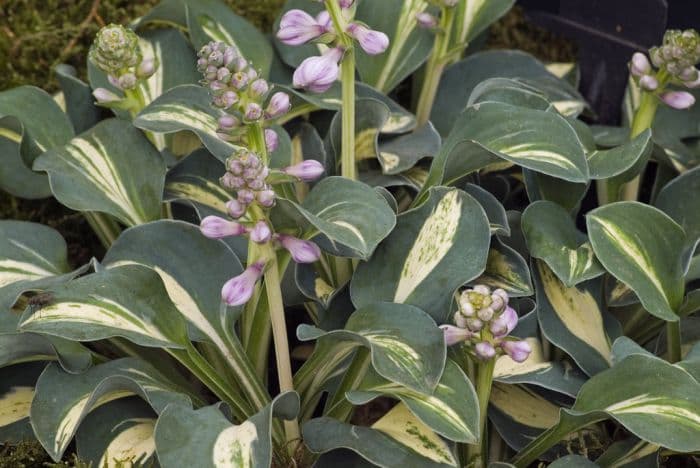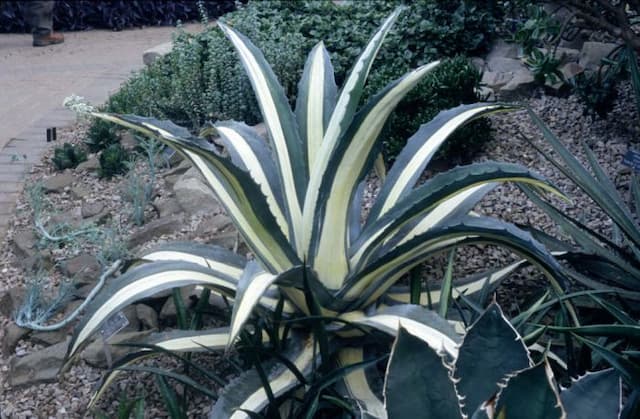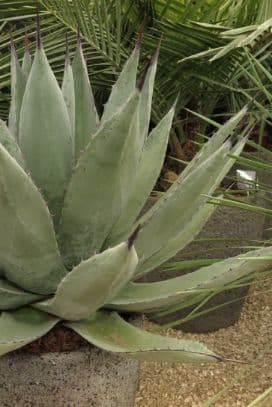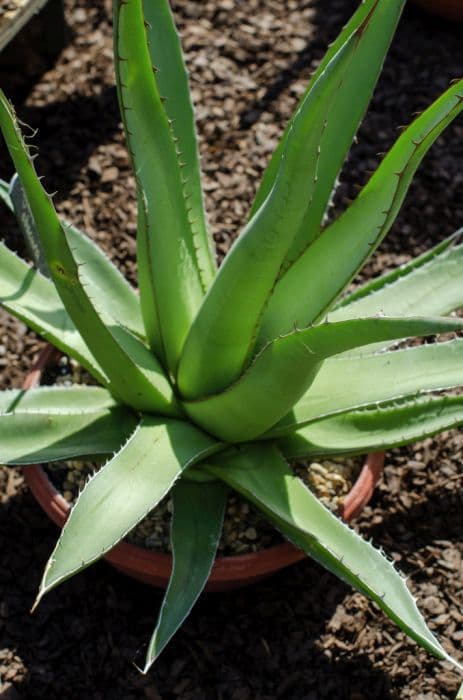Mouse Ears Hosta Hosta 'Snow Mouse' (v)

ABOUT
Hosta 'Snow Mouse' is a charming variety that stands out for its unique and ornamental foliage. It has thick, heart-shaped leaves with a distinct appearance. The base color of the leaves is a deep green, which is beautifully contrasted by a creamy white to yellow margin that outlines each leaf, giving it a whimsical 'frosted' effect that might remind one of snow outlining each leaf. These variegated leaves bring a splash of brightness to shady garden areas. The texture of the leaves is another notable feature; they have a heavy substance which gives them a puckered look, with prominent veins that add to the textural contrast. Over time, the leaves form a dense, mounded clump that serves as an excellent ground cover or a delightful accent in a shade garden. As the growing season progresses, Hosta 'Snow Mouse' may produce delicate stems that rise above the foliage. On these stems dangle bell-shaped flowers, usually a lavender or soft purple color. These blossoms add an extra layer of visual interest to the plant and can attract pollinators to the garden. Bear in mind that while the overall aesthetic can be striking, the petite nature of the plant makes it a perfect choice for border fronts, containers, or as a specimen in small garden spaces where a touch of whimsical foliage is desired. Its coloration and compact form make it a favored choice for gardeners who appreciate detailed texture and color variegation in their plant selections.
About this plant
 Names
NamesFamily
Asparagaceae
Synonyms
Plantain Lily, Funkia, Hosta
Common names
Hosta 'Snow Mouse'
 Toxicity
ToxicityTo humans
Hosta plants, commonly referred to simply as hostas, are not highly toxic to humans. However, if ingested in large quantities, they could potentially cause mild stomach upset or diarrhea. In most cases, accidental ingestion of hosta leaves or flowers is not cause for concern, and serious complications are rare.
To pets
Hostas are known to be toxic to pets, particularly to cats and dogs. If your pet ingests any part of a hosta plant, they may exhibit symptoms such as vomiting, diarrhea, and depression. While hosta poisoning is typically not life-threatening, it can cause considerable discomfort to your pet, and veterinary attention may be required to manage the symptoms and ensure your pet's well-being.
 Characteristics
CharacteristicsLife cycle
Perennials
Foliage type
Deciduous
Color of leaves
Variegated
Flower color
Lavender
Height
6 inches (15 cm)
Spread
1 foot (30 cm)
Plant type
Herb
Hardiness zones
3
Native area
Asia
Benefits
 General Benefits
General Benefits- Ornamental Appeal: 'Hosta' plants are primarily grown for their attractive foliage that can provide visual interest to garden spaces.
- Shade Tolerance: They are well-suited for shaded areas where many other plants might struggle to thrive.
- Low Maintenance: Hostas generally require minimal care once established, making them suitable for novice gardeners.
- Variety of Sizes: They come in various sizes, which allows them to fit into different landscape designs and garden spaces.
- Soil Versatility: Hostas can adapt to a range of soil conditions, though they prefer moist, well-drained soils.
- Pest Resistance: While not immune to pests, many hostas are resistant to common garden pests like deer and rabbits.
- Texture Contrast: With their lush foliage, they add a contrasting texture to gardens, especially when paired with plants that have finer foliage.
- Seasonal Interest: Some hostas, including 'Snow Mouse', can have variegated leaves or produce flowers that add seasonal interest.
- Border and Edging: Their compact size and foliage make them excellent for use in borders or as edging plants.
- Propagation: Hostas can be easily divided for plant propagation, allowing gardeners to create more plants and fill in garden spaces economically.
 Medical Properties
Medical PropertiesThis plant is not used for medical purposes.
 Air-purifying Qualities
Air-purifying QualitiesThis plant is not specifically known for air purifying qualities.
 Other Uses
Other Uses- Miniature Garden Focal Point: Hosta 'Snow Mouse' can serve as a charming centerpiece in a fairy or miniature garden due to its small size and attractive foliage.
- Container Gardening: This variety is well-suited for containers on patios or balconies where space is limited and its variegated leaves can be appreciated up close.
- Bonsai Complement: Hosta 'Snow Mouse' can be used to complement bonsai displays, offering a contrast in shape and texture at the base of the bonsai tree.
- Craft Projects: The uniquely shaped leaves can be used in various craft projects, such as leaf printing or embedding in resin for decorative items.
- Photography Subject: Due to its distinct appearance, the plant makes an excellent subject for botanical photography, highlighting the intricacies of its leaves.
- Floral Arrangements: The foliage can be incorporated into cut flower arrangements to provide a lush green backdrop for other blooms.
- Stamping Patterns: Leaves can be painted or inked to create natural stamping patterns on fabric or paper for art projects.
- Teaching Tool: Hosta 'Snow Mouse' can be used in educational settings to teach children about plant growth, variegation, and the importance of foliage plants.
- Accent in Water Features: Placed around ponds or water features, it can create visual interest and complement aquatic plants.
- Seasonal Decorations: Leaves can be harvested and dried to make natural decorations for fall displays or wreaths.
Interesting Facts
 Feng Shui
Feng ShuiThe Hosta is not used in Feng Shui practice.
 Zodiac Sign Compitability
Zodiac Sign CompitabilityThe Hosta is not used in astrology practice.
 Plant Symbolism
Plant Symbolism- Resilience: Hostas are hardy plants that can thrive in a variety of conditions, symbolizing the ability to endure and recover from challenges.
- Adaptability: With their capability to grow in shade or partial sun, Hostas represent the flexibility to adapt to changing situations.
- Longevity: Because they are perennials that return each year, Hostas can be symbolic of long life and permanence.
- Self-care: Due to their preference for shade, the Hosta is sometimes seen as a symbol for self-care and recognizing one’s need for rest or retreat.
- New beginnings: The way Hostas emerge anew each spring can symbolize fresh starts or new opportunities.
 Water
WaterHostas, commonly referred to as plantain lilies, should be watered deeply and thoroughly, ensuring that the soil is evenly moist but not waterlogged. Initially, water your Hosta 'Snow Mouse' about 1 to 1.5 gallons per week, especially during the growing season. The frequency can vary depending on climate and soil conditions, but a general rule is to water whenever the top inch of soil feels dry to the touch. In hotter climates or during particularly dry spells, you may need to water twice a week. Always avoid overhead watering to prevent leaf scorch and reduce the risk of fungal diseases.
 Light
LightPlantain lilies thrive best in partial to full shade. They can be grown in various lighting conditions but perform optimally when shielded from the harsh afternoon sun. An ideal spot for your Hosta 'Snow Mouse' is under the canopy of trees providing dappled sunlight or in a north-facing garden where it can enjoy bright, indirect light. Ensure that the plant receives enough light to encourage lush foliage but not so much that its leaves burn or bleach.
 Temperature
TemperaturePlantain lilies are hardy and tolerate a wide range of temperatures, but they grow best when daytime temperatures are between 60°F and 80°F. They can survive minimum temperatures down to about 30°F but should be protected from frost and freezing conditions. Ideal temperatures for Hosta 'Snow Mouse' are moderate rather than extreme; it does not thrive in very hot or very cold weather.
 Pruning
PruningPrune your Hosta 'Snow Mouse' to remove any dead or damaged leaves and to maintain a tidy appearance. This is best done in the spring before new growth begins or in the fall after the plant has gone dormant. Pruning encourages healthy growth and air circulation, which can prevent disease. It is not necessary to prune regularly, but doing so can promote the aesthetic appeal of the plant.
 Cleaning
CleaningAs needed
 Soil
SoilThe best soil mix for a Hosta, commonly known as 'Snow Mouse', is well-draining and rich in organic matter. A mix of peat moss, compost, and perlite or pine bark works well. The soil pH should be slightly acidic to neutral, ranging from 6.0 to 7.5.
 Repotting
RepottingHostas, including the 'Snow Mouse' variety, generally do not require frequent repotting and can be done every 3-4 years or when the plant becomes root-bound.
 Humidity & Misting
Humidity & MistingHostas like 'Snow Mouse' prefer average to high humidity levels, but being adaptable, they can tolerate a wide range. Aim for a humidity level between 50-70% for optimal growth.
 Suitable locations
Suitable locationsIndoor
Place in filtered light and ensure soil moisture for best indoor growth.
Outdoor
Plant in partial shade and ensure moist, fertile soil for outdoor growth.
Hardiness zone
3-9 USDA
 Life cycle
Life cycleHosta 'Snow Mouse' begins its life cycle when conditions are favourable, typically in spring when its rhizomes, or underground stems, send up shoots. The shoots develop into distinctive, heart-shaped, variegated leaves that form a mounded clump. By late spring to early summer, Hosta 'Snow Mouse' produces stalks above the foliage topped with bell-shaped, lavender or white flowers, attractive to pollinators like bees. Following pollination, the plant may produce seed pods, although propagation is commonly achieved through division of the rhizomes. As fall approaches and temperatures drop, the leaves will yellow and die back as the plant enters dormancy. The cycle is renewed the following spring when temperatures rise and the growing conditions become optimal again, prompting the rhizomes to sprout new growth.
 Propogation
PropogationPropogation time
Early Spring
The most popular method of propagating the Hosta 'Snow Mouse', commonly known as Hosta, is by division. This is best done in the spring as the new shoots are emerging from the ground, usually in late March to April. Once the Hosta begins to unfurl its leaves and the shoots are about 2 to 6 inches (5 to 15 cm) tall, it's an ideal time to divide. Carefully dig around the plant with a shovel, lifting it out of the ground with as much of the root system intact as possible. Gently tease apart the plant into smaller sections, each with at least two or three shoots and a portion of the root system. Replant the divisions immediately, spacing them at the same depth they were previously growing and water thoroughly to help establish the new plants. This simple process helps to maintain the health of the Hosta, encourages growth, and multiplies your collection efficiently.









